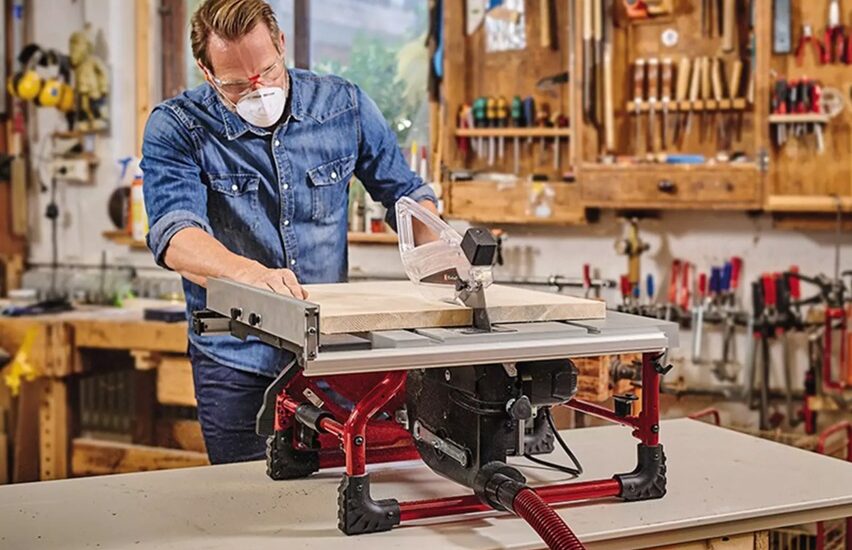When it comes to woodworking, a scie sur table (French for “table saw”) is one of the most valuable tools in any workshop. This powerful and versatile piece of machinery allows woodworkers to make precise cuts with ease and efficiency. Whether you’re a professional carpenter or a DIY enthusiast, understanding how to use a table saw and knowing which features to look for can make a significant difference in the quality of your projects.
In this article, we’ll explore what a scie sur table is, how it works, its different types, and how to use it safely. By the end, you’ll have a better understanding of this essential tool and how it can help you take your woodworking to the next level.
Table of Contents
What is a Scie sur Table?
A scie sur table is essentially a large, powerful saw mounted on a flat surface, typically a table. The blade is mounted horizontally, with the material being fed through the saw, allowing for straight, precise cuts. The primary function of this saw is to cut wood, but it can also be used for other materials like plastic and metal, depending on the type of blade installed.
The key feature of a table saw is its ability to make straight cuts over a large area, making it an indispensable tool for tasks like ripping (cutting along the length of a board) and cross-cutting (cutting across the width of a board).
Types of Scie sur Table
There are several different types of scie sur table, each designed for specific tasks. Understanding the differences can help you choose the best one for your needs.
Contractor Table Saws
Contractor table saws are designed for smaller workshops and more mobile users. They typically have a more compact frame and are lighter than other types of table saws. Despite their smaller size, they can handle a variety of cutting tasks, making them a popular choice for woodworkers who need a portable option.
Cabinet Table Saws
Cabinet table saws are heavy-duty machines designed for professionals who need precise, high-quality cuts. They have a more robust build, including a stronger motor and better dust collection systems. These saws are often larger and more expensive, but they provide unmatched accuracy and durability, making them ideal for serious woodworking projects.
Benchtop Table Saws
Benchtop table saws are compact and lightweight, making them a good choice for people with limited workspace or those who need a portable saw. While they might not be as powerful as larger models, they are still capable of handling smaller to medium-sized woodworking projects. Benchtop saws are perfect for beginners or DIYers.
Hybrid Table Saws
Hybrid table saws combine features of both contractor and cabinet saws. They provide a good balance of performance, portability, and price. They are ideal for hobbyists and intermediate woodworkers who need more power and precision than a benchtop model, but don’t necessarily require the heavy-duty capacity of a cabinet saw.
Key Features to Look for in a Scie sur Table
When shopping for a scie sur table, there are several important features to consider. Each feature will impact how well the saw performs and how easy it is to use. Here are some of the top features to keep an eye on:
Motor Power
The motor is what drives the blade of the saw, and its power determines how easily the saw can cut through different materials. If you’re working with hardwoods or thick boards, you’ll need a more powerful motor to get clean cuts. Most table saws come with motors ranging from 1.5 to 5 horsepower, depending on the type of saw.
Rip Capacity
Rip capacity refers to the maximum width of the material that can be cut. A larger rip capacity allows you to cut wider boards, which is especially useful for larger projects. When choosing a scie sur table, consider the size of the materials you’ll be working with and choose a saw with a rip capacity that suits your needs.
Blade Size
The blade size determines how deep the saw can cut into the material. Most table saws come with a 10-inch blade, but there are also 8-inch and 12-inch options available. Larger blades can cut thicker materials, but they also require more power and may not be necessary for all users.
Fence System
The fence is what holds the material in place while you cut. A high-quality fence system will make it easier to make accurate cuts. Look for a fence that is easy to adjust, stays in place, and is parallel to the blade. A good fence system can make a huge difference in the quality of your cuts.
Dust Collection
Woodworking can create a lot of dust, which is not only messy but can also be harmful to your health. Many modern scie sur table models come with dust collection systems that help keep your workspace clean and free of sawdust. If you plan on using the saw frequently, investing in a dust collection system can improve your work environment.
How to Use a Scie sur Table Safely
Using a scie sur table requires care and attention, as the saw’s powerful motor and sharp blade can be dangerous if not handled properly. Here are some essential safety tips to keep in mind:
Wear Protective Gear
Always wear protective gear when using a table saw. This includes safety glasses, hearing protection, and a dust mask. The noise and dust created by the saw can be harmful to your hearing and lungs, so it’s important to protect yourself.
Keep Your Hands Away from the Blade
One of the most important safety rules when using a scie sur table is to keep your hands away from the blade at all times. Always use a push stick or push block to feed the material through the saw, and never try to push the material too close to the blade with your hands.
Use the Blade Guard
Most table saws come with a blade guard, which is designed to protect you from accidental contact with the blade. Always use the blade guard, as it can help prevent injuries. If you need to remove the guard for a specific cut, make sure to replace it immediately afterward.
Check the Saw Before Each Use
Before using your scie sur table, always check the saw for any issues. Make sure the blade is sharp, the fence is aligned properly, and the motor is functioning correctly. Regular maintenance and inspection can help prevent accidents and ensure the saw performs at its best.
Work in a Well-Lit Area
Always use your table saw in a well-lit area so that you can clearly see what you’re doing. Good visibility reduces the risk of making mistakes and helps you make precise cuts.
Conclusion
A scie sur table is an essential tool for anyone serious about woodworking. Whether you’re cutting wood for a DIY project or working on professional carpentry, a table saw can make your tasks easier and more accurate. By understanding the different types of table saws, key features to look for, and proper safety precautions, you’ll be well-equipped to choose and use the right table saw for your needs.






